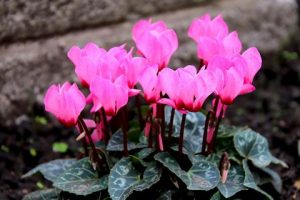Instead of bouquets, try blooming plants for Valentine’s Day
University of Illinois Extension Services — February 8, 2021
Cyclamens have unique heart-shaped leaved and showstopper flowers that can bloom for four to six weeks making them a great Valentine’s Day gift. (Pixabay photo)
The tradition of giving flowers to family and friends to express affection on Valentine’s’ Day began centuries ago. Give your loved one a gift this year with bloom that can be enjoyed long after Feb. 14.
“Blooming houseplants are great alternatives to traditional bouquets of cut flowers,” says Brittnay Haag, University of Illinois Extension horticulture educator. “With a little care and maintenance, these plants can thrive in your house, or office and rebloom multiple times.”
Kalanchoe
This waxy-leafed succulent is low maintenance and has colorful blooms. Kalanchoe flowers can be red, pink, yellow, or white. Cut off the blooms once they are faded to encourage new buds to form. This plant can be easily overwatered, so be sure to allow the soil to dry out completely before watering.
Kalanchoe grows best in bright, indirect sunlight and may get leggy in low-light conditions. It can also be easily propagated by stem or leaf cuttings to create new plants. Place the plant outside in the summer to grow and bring it inside before the first frost. Kalanchoe will develop flower buds in response to the long nights of fall.
Cyclamen
These heart-shaped leaf plants have unique foliage and showstopper flowers that can bloom for four to six weeks. Flowers can be a variety of shades of red, pink, and white. Water Cyclamens at the base of the plant when it dries out, soaking the soil until water flows out the bottom drainage holes.
Cyclamens grow best in bright, indirect sunlight and thrive in cooler temperatures, 55°F to 60°F. Cyclamens will go dormant after they bloom, with foliage yellowing and dying down to the soil. Remove the dried foliage and place the container in a cool, dark place for two months.
After the dormancy period, resume watering, add Cyclamen bulbs to a new container of soil, and place it in bright, indirect light. New foliage should start growing soon, with blooms following a couple of months later.
Miniature Rose
Instead of an arrangement of cut roses that will die after a week, give someone the whole plant. Delicate, miniature rosebuds can be found in red, pink, or white and can be deadheaded to encourage new blooms. When grown indoors, roses need bright sunlight in a south-facing window and constant temperatures ranging from 60°F to 75°F. Lightly mist the foliage daily to maintain humidity levels.
They can be planted outdoors in a container, or the ground in the summer, but bring them inside before the first frost. Most miniature roses will go dormant in the winter and begin to grow again in the spring.
Orchid
Many orchid species grow well indoors. Phalaenopsis are commonly found in stores and are the easiest to care for. While orchids can be a challenge to rebloom, they will if placed in a window with bright, indirect light.
Orchids also need a good source of humidity. They do well in the kitchen, a bathroom, or on a tray of gravel and water. Water orchids weekly with collected rainwater, or distilled water until it flows out of the drainage holes and fills the tray below.
Allow the soil to dry out between waterings. Mist the plant frequently to maintain the surrounding humidity levels.
If looking for something a little more unique, try a potted Venus Flytrap, a sensitive plant, an air plant, or a succulent.
“Head to your local garden center this Valentine’s Day and pick up one of these blooming houseplants to remind someone how much you love them all year,” Haag says.
Visit Illinois Extension’s website at extension.illinois.edu/global/horticulture for more information about houseplant care and maintenance.



